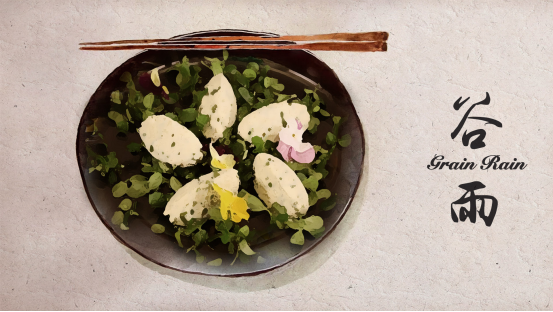
Guyu, or Grain Rain, is the sixth solar term according to the traditional Chinese lunar calendar, making it the last term of spring. The term usually arrives around April 19-21.
The Grain Rain signals the end of cold weather and a rapid rise in temperature. It originates from the old saying, “Rain brings the growth of hundreds of grains,” which shows that this period of rainfall is crucial for crops. Grain Rain brings a marked increase in temperature and rainfall. It’s an important time to protect plants from insects and other pests.
In southern China, people traditionally drink tea on the day of Grain Rain. Spring tea during Grain Rain is rich in vitamins and amino acids (氨基酸), which can help to remove heat from the body and is good for the eyes. Drinking tea on this day is also said to prevent bad luck. People in northern China traditionally eat Chinese toon (香椿), a leafy vegetable native to eastern and southeastern Asia, during Grain Rain. An old Chinese saying goes “Chinese toon before the rain is as tender as silk.” The vegetable is nutritious and can help to strengthen the immune system. It is also good for the stomach and skin.
The Grain Rain Festival is celebrated in fishing villages across the coastal areas of northern China. Grain Rain marks the start of the fishermen’s first voyage of the year. The custom dates back more than 2,000 years, when people believed they owed a good yield to the gods, who protected them from stormy seas. People would worship the sea and make sacrifices during the Grain Rain Festival, praying for a good harvest and the safe return of loved ones.
Guyu also sees the bloom of the peony (牡丹), which is known as the “Queen of All Flowers” in Chinese culture. As a result, many people go out to admire the local peonies. In Shandong, Henan and Sichuan, there are even festivals to appreciate the beauty of the peony when Guyu falls.
分享本文十五分钟后截图给客服,获赠“单词速记软件”自选一册书!
原创编写 版权所有 侵权必究! 每日更新 个性化阅读 英语飙升!
1.What can we know about Grain Rain?
A It brings rain and crops.
B It is the key time for farmers.
C It sees slowly rising temperature.
D It happens in the beginning of summer.
解析:选B。B推理判断题。根据第二段的“this period of rainfall is crucial for crops”“It’s an important time to protect plants from insects and other pests.”谷雨期间的降雨对农作物至关重要,且是保护作物免受昆虫和其他害虫侵害的重要时刻。即谷雨对农民来说很重要。故选B。
2.Which of the following can be a subtitle for Para. 3?
A Time to eat Chinese toon.
B Gold time for agriculture.
C Taste of Grain Rain.
D History of Grain Rain.
解析:选C。C段落大意题。根据第三段的“In southern China, people traditionally drink tea on the day of Grain Rain.”和“People in northern China traditionally eat Chinese toon”可知,在我国南方,人们在谷雨这天喝茶,在北方,人们在谷雨期间吃香椿。即该段主要讲的是谷雨期间的特殊饮食。故选C。
3.Which is NOT true about the Grain Rain Festival?
A It has a long history.
B People pray for safety.
C Fishermen hope for harvest.
D It’s celebrated in southern China.
解析:选D。D细节理解题。根据倒数第二段第一句“The Grain Rain festival is celebrated in fishing villages across the coastal areas of northern China.”可知,在我国北方沿海一带,渔民们常常在谷雨节祭海,祈祷海神保佑出海平安、满载而归。故选D。
4.Why do people appreciate the peony during Guyu?
A For its great reputation.
B For the bright sunshine.
C For local festivals.
D For a cool environment.
解析:选A。A细节理解题。根据最后一段的“which is known as the ‘Queen of All Flowers’ in Chinese culture. As a result, many people go out to admire the local peonies.”在中国文化中,牡丹被称为“百花之王”,因此,很多人在谷雨外出观赏当地的牡丹。即因为牡丹的盛名而心向往之。故选A。
